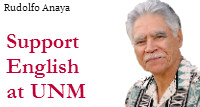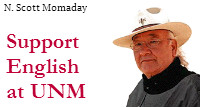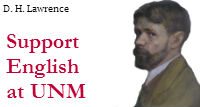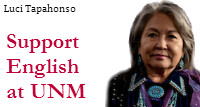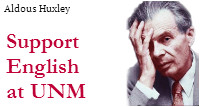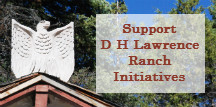Fall 2019 Course Descriptions
500.001: Introduction to the Professional Study of English
TR 1230-1345
Jesse Alemán, jman@unm.edu
This course prepares students for literary studies at the graduate level. It will introduce students to the English Department’s graduate requirements, policies, and programs; students will also learn about the resources of the UNM’s libraries. We will cover fundamental bibliographic, research, and MLA methods and learn the major and minor genre conventions expected in graduate coursework and in the profession. It will be a (low-risk) writing intensive class combined with a high degree of participatory pedagogy expected in and out of the scheduled class time, with the overall goal of ushering students into the professional, scholarly expectations of literary studies.
501.001: Introduction to the Profession for Writers
M 1600-1830
Daniel Mueller, dmueller@unm.edu
In this course we’ll examine all aspects of the writing life, from the professional to the personal and the balancing act that most writers perform in order to support themselves and their families while engaged in the production of literature. We’ll examine creative writing’s history in the academy; teaching inside and outside the hallowed halls including pedagogical strategies; publishing (traditional, corporate, university, indy, self, and online); finding an agent; applying for fellowships, teaching positions, and prizes; organizing one’s time; and participating in the global, national, and local literary communities as book reviewers, bloggers, teachers, editors, interviewers, interviewees, publicists, and experts. For sure we’ll read bell hooks, Teaching to Transgress: Education as the Practice of Freedom, Stephanie Vanderslice and Kelly Ritter, Teaching Creative Writing to Undergraduates, Betsy Lerner’s The Forest for the Trees, Carolyn See’s Making a Literary Life, and Seth Abrahamson’s “A Brief History of Creative Writing.” Expect excerpts from Sven Birkert’s The Gutenberg Elegies, D.G. Myers’ The Elephants Teach, Dale Peck’s Hatchet Jobs, random handouts, and many special guests. Assignments: a “Why I Write” personal essay drafted and revised, an investigation into a book’s journey from manuscript to edition, and a book review drafted, revised, and submitted for publication. The course is required for all MFA students wishing to teach English 224/Introduction to Creative Writing.
510.001: Criticism & Theory
M 1600-1830
Belinda Deneen Wallace, bwallace@unm.edu
Our course will introduce us to some of the major thinkers and movements of Critical Race Theory (CRT) from the late 20th century through the present. In so doing, we will consider how CRT offers various lenses and tools that will enhance our ability to interpret/understand, write about, and teach literature. The field of Critical Race Theory dates back to 1989 and has since grown significantly. Its influence can be seen in other related theories such as intersectionality, queer critique of color, transfeminism, and black feminist thought—in fact, some may consider these areas sub-fields of Critical Race Theory. CRT as a theoretical framework is also historical in the sense that it examines contemporary social structures and attitudes within context of other historical developments, including the spread of European colonialism and imperialism. Although Critical Race Theory has its origins in Critical Legal Studies, CRT has expanded to include an array of perspectives and concerns—such as, race relations, racism, ethnic stratification, immigration, economic inequities, and gendered politics. As we develop an intimate understanding of CRT, we will be introduced to important critics like Richard Delgado; Kimberlé Crenshaw; Howard Winant; María Lugones; Robin DiAngelo; Eduardo Bonilla-Silva; Ruth Frankenberg; Ian F Haney-López; Patricia Hill Collins; Michael Omi; and Jacqui M. Alexander, whose work will serve as representations of the specific form of CRT we will study.
516.001: American Biography & Autobiography
R 1600-1830
David Dunaway, dunaway@unm.edu
This is a creative non-fiction workshop to help students write, criticize, and appreciate biography and autobiography. Classwork and reading emphasize narrative strategies, writing techniques, and literary history with a clear end: the writing of a chapter of your autobiography and another biographical chapter on a literary figure.
Graduate students contrast biography and autobiography of Jack Kerouac, Maya Angelou, and others, comparing organization, stylistics, and research. The course counts for either a graduate literary seminar or a workshop course. Books are at the UNM Bookstore; UNM’s e-reserve system has the on-line reader for printing and reading.
519.001: Visual Rhetoric
M 1600-1830
Julianne Newmark Engberg, newmark@unm.edu
In the interdisciplinary course ENGL 519, Visual Rhetoric, students will engage with theories and practices of the production and consumption of visual images. We will consider the historical aspects of the generation and use of images, as they have functioned as persuasive, rhetorical mediums in political, social, and personal domains. On the subject of visual communication artifacts as mediums, we will study multimedia communication, multimodal delivery, and the unique challenges and resonances of hypertextual modes. Students will develop a vocabulary in rhetorical studies in two primary realms: one concerns the creation and use of images as tools in commercial and political domains and the other concerns teaching and learning in a variety of interdisciplinary fields with their growing multimodal dimensions. We will inquire into the significance of the late-twentieth-century “pictorial turn” and we will probe the function of our mediated relationships to visual texts of many kinds as we proceed into the twenty-first century.
Students in this course will:
• give a classroom presentation that is a case-study analysis of a visual artifact of her/his choice (or of his or her design and creation), focusing on the historical, utilitarian, and sociocultural significances of the artifact;
• create a multimodal visual rhetoric portfolio with substantive analysis (one component of which can be the above case-study analysis);
• compose a final course project that harmonizes theory and practice in visual rhetoric; the project can be completed in a medium of the student’s choice, pending approval of Dr. Newmark after a one- on-one conference and a workshop with class peers;
• complete a series of shorter writing assignments in the veins of analysis, discussion, and response
520.001: T: Blue Mesa Review
TR 1400-1515
Mark Sundeen, marksundeen@unm.edu
This class introduces you to the production of UNM’s national literary magazine, Blue Mesa Review. We receive hundreds and sometimes thousands of submissions each year from authors hoping to see their stories, essays, or poems published in our journal. Your primary responsibility in this course is to assess these submissions—collectively called “slush”—for possible publication in BMR. In addition, you will keep an informal journal about your participation in slush, attend discussion meetings, and write a few short papers. This class requires you to be self-motivating; in some respects, it is very much like an independent study. You must be able to keep up with the workload on your own—and often on your own time.
520.002: T: Rhetoric of Wine
W 1600-1830
Michelle Kells, mkells@unm.edu
We are rhetorical beings, shaping and influencing our environments with (social, physical, spiritual, political, economic, etc.) through language and symbol. Francis Bacon succinctly defined rhetoric as the “art of applying reason to the imagination for the better moving of the will.” And who can resist Bacon? Nothing moves us to action or imagination better than a good trope! Tropes are more than rhetorical schemas and stylistic devices. Tropes (metaphor, metonymy, synecdoche, and irony) together with their “kissing cousins” Topoi and Enthymemes (or the more popularly recognized manifestation known as “Memes”) function as forms of Epistemic Rhetoric by mediating and constructing knowledge and the quasi-logical universe of human communication. These complex and abstract concepts become far more palpable and pleasurable to contemplate when paired with a good glass of wine!
522.001: Creative Writing Workshop - Poetry
W 1600-1830
Cedar Brant-Smith, cedarbrant@unm.edu
This graduate poetry workshop will be focused on the writing and reading of contemporary poetry, yours and others. Students in this course will write poems which will comprise the bulk of our text, and we will read new poetry coming from the emerging and established writers that form our larger writing community. The emphasis will be both on the craft—the language, music, and form, and the vision, the imagination at the root of all good writing.
523.001: Creative Writing Workshop - Nonfiction
T 1600-1830
Gregory Martin, gmartin@unm.edu
This is a writing workshop focused on revision. Each student will write two new pieces of creative nonfiction. We will workshop each piece twice. Then, each of you will choose one of these two essays to revise again, and you will submit this at the end of the semester to six literary magazines. The goal of the course is to push you to produce more than you thought you could, to break down what Jane Smiley calls “evasion strategies.” The particular subgenre of creative nonfiction you may turn in to the workshop is wide open: Autobiographical Narrative (an essay that has the dramatic structure of a short story); a Lyric Meditation (a more “classic” Montaigne-like essay that is structured meditatively or philosophically or associatively); Profile; Travel Writing; Literary Journalism; a hybrid essay that combines two or more of these forms. It's all fair game.
Readings for discussion in class will consist of (1) published essays from a variety of the subgenres above, as well as (2) essays on craft. In selecting pieces for us to read and discuss, my aim is for eclecticism--to give you a sense of the range of literary nonfiction, to give you a sense of the possibilities of the form. My hope is that the course will push you stylistically and technically, and encourage you to take risks, to raise your standards for what you consider good writing, and then to meet those standards through the development of the habit of art.
530.001: Teaching Composition
August 12-August 16 - MTWRF 0900-1300
Lab - August 19-December 7 - TR 0930-1045
Bethany Davila, bdavila@unm.edu
This course is designed for new teachers in UNM’s Core Writing Program. You will learn and apply current theory and pedagogy in Composition Studies and Rhetorical Genre Studies to guide you as a teacher of diverse student writers. We use a genre approach in our writing program because we recognize that FYC (first year composition) courses should aim toward helping students gain skills, habits, strategies, and experience that will transfer or can be applied to other college courses across the disciplines and to personal and professional writing situations. As Anne Beaufort asks in College Writing and Beyond, “How can we set students on a life-long course of becoming expert writers,” which she answers with “Let them practice learning new genres and the ways of new discourse communities . . . and challenge them to apply the same tools in every new writing situation” (158).
We begin the week before the start of the fall semester, when we will review with you the goals, values, and student outcomes of the Core Writing Program and provide you with course materials for the semester so you can hit the ground running. Over the course of the rest of the semester, we will focus on issues of professional development as a teacher-scholar through reading, research, class discussion, conferencing, and course projects. Topics will include best practices in teaching and assessing writing, teaching multilingual writers, creating multimodal assignments, culturally sustaining pedagogy, reading instruction, metacognition, and more. This is a three-credit graduate course.
530.002: Teaching Composition
August 12-August 16 - MTWRF 0900-1300
Lab - August 19-December 7 - TR 0930-1045
Cristyn Elder, celder@unm.edu
This course is designed for new teachers in UNM’s Core Writing Program. You will learn and apply current theory and pedagogy in Composition Studies and Rhetorical Genre Studies to guide you as a teacher of diverse student writers. We use a genre approach in our writing program because we recognize that FYC (first year composition) courses should aim toward helping students gain skills, habits, strategies, and experience that will transfer or can be applied to other college courses across the disciplines and to personal and professional writing situations. As Anne Beaufort asks in College Writing and Beyond, “How can we set students on a life-long course of becoming expert writers,” which she answers with “Let them practice learning new genres and the ways of new discourse communities . . . and challenge them to apply the same tools in every new writing situation” (158).
We begin the week before the start of the fall semester, when we will review with you the goals, values, and student outcomes of the Core Writing Program and provide you with course materials for the semester so you can hit the ground running. Over the course of the rest of the semester, we will focus on issues of professional development as a teacher-scholar through reading, research, class discussion, conferencing, and course projects. Topics will include best practices in teaching and assessing writing, teaching multilingual writers, creating multimodal assignments, culturally sustaining pedagogy, reading instruction, metacognition, and more. This is a three-credit graduate course.
532.001: Teaching Multimodal and Online Composition
August 5-August 16 - MTWRF 0900-1300
Lab - Online
Tiffany Bourelle, tbourell@unm.edu
This course will be an Augustmester course from August 5th-August 16th, with an online lab component throughout the semester. In this class, students will learn the theory behind online teaching and multimodal composition. Beth Hewett and Christa Ehmann (2004) indicate that teachers are often concerned about teaching online for the first time; however, they suggest that this worry is caused by a lack of proper training. This course will prepare students to teach an online course, helping them understand the best practices of designing a course, facilitating course discussions, holding online conferences, and providing feedback. In addition, the class will also be practical, as students will develop a first-year course shell to teach in the subsequent semester (if eligible). The first-year class students will teach will be part of our online program, eComp, which is based on a multimodal pedagogy, where students are asked to choose their medium in response to the needs of their audience and the purpose of the document. As such, this English 532 class will teach graduate students the theory and practice of multimodal composition, helping them create materials such as assignments and multimodal instructional tools that mimic the texts first-year students develop.
551.001: Medieval Romance & Race
TR 1400-1515
Nahir Otaño Gracia, nahir@unm.edu
This course explores the connections between medieval romance and race by examining the social, cultural, and literary patterns that helped create one of the most popular genres of the European Middle Ages (c. 1240-1400). Medieval romance tends to express nostalgia through the creation of foundational myths, fantastical encounters, and gendered interactions that helped create a national past. Perhaps more important to our discussion will be how race—defined as “a structural relationship for the articulation and management of human differences” (Heng, Invention of Race, 27)—helped create and express this nostalgia and desire for origins. Other important topics include: gender (women as agents and obstacles to male desire), class (who was reading romance and why?), and the boundaries and limitations of the romance genre (both ideological and physical). We will read and discuss a variety of romances in their original Middle English and in translation
556.001: Going Gothic, Getting Romantic
T 1600-1830
Pamela Cheek, pcheek@unm.edu
This course explores the emergence at the end of the eighteenth century and beginning of the nineteenth century of political, aesthetic, and cultural codes that continue to dominate fiction and visual media. Both the Gothic and Romanticism emerged in relation to revolutionary and post-revolutionary displacement of people across Europe and in the circum-Atlantic. We will read well-known and lesser-known novels and poetry from the French and English traditions against each other as we make connections with twenty-first century Gothic and Romantic modes for addressing displacement, statelessness, violence, passion, family, slavery, history, and nature.
564.001: Advanced Study of Native and Indigenous Literature
TR 1400-1515
Sarah Hernandez, hernands@unm.edu
This seminar is an introduction to American Indian literary studies, and explores the major authors, ideas, and controversies that currently dominate the field. This course examines the different, and often contradictory, literary methodologies that scholars use to analyze and critically engage with American Indian literature. Specifically, we will apply these theories to texts composed by Southwest writers, and consider how these literary representations have shaped our knowledge of and interaction with the 23 tribes and pueblos in the state of New Mexico.
587.001: Narrative Design
R 1600-1830
Gregory Martin, gmartin@unm.edu
This is a graduate craft seminar for creative writers of any genre interested in the architecture of stories. Together, we will investigate how narrative design creates and deepens meaning and resonance. We will study how writers of fiction and nonfiction prose, at the booklength and at the story and essay level, innovate and experiment with form and architecture, to subvert and challenge expectations and understanding of what a story might be and how it can be made. We will be looking for models, looking to be influenced, seeking to expand our sensibility. Each week we will ask the questions: How was this made? How does this work? What is its design? Its organizing principles? How does an understanding of its design shape my own work-in-progress and fuel my ambition?
587.002: T: C20 Poems - Long & Short
T 1600-1830
M.R. Hofer, mrh@unm.edu
This course in modernist and postmodernist literature will involve extensive thinking about both the longest and the shortest texts that can be properly defined as poems. We will consider how a succession of styles for short poems evolved in the 1910s, 1930s, and 1950s, and how these smaller units have been related to subsequent larger structures, in turn inviting speculation about the nature and function of the twentieth-century “epic” (with reference to scope rather than any strict adherence to conventional definitions of the genre). In the process, we will also ask questions about writing and reading, influence and canonicity. The project of this course ultimately involves defining the art of poetry at its limits, through careful and extended attention to form.
Each of the three main modules entails an extended consideration of a productive relationship between a writer who was known for developing a more terse or sparse style and another who is known for publishing a major long poem. In this way it means to trace a tradition of innovative writing through the twentieth century, from Imagism to Objectivism to Projectivism. However, it will conclude with an experimental contemporary epic—M. NourbeSe Philip’s Zong!—that at once draws upon and complicates this tradition in a manner that reveals much about the literary culture of the present.
Students will produce a research project in three stages during the latter half of the term. Creative as well as critical research projects are welcome, though the specific terms of any creative project must be determined in advance and in consultation with the instructor. The course is designed to serve MA, PhD, and MFA students.
Possible authors include H.D., Ezra Pound, William Carlos Williams, Lorine Niedecker, Louis Zukofsky, Robert Creeley, Charles Olson, and M. NourbeSe Philip.
660.001: SEM: Mark Twain and Race in America
W 1600-1830
Finnie Coleman, coleman@unm.edu
I have no race prejudices, and I think I have no color prejudices or caste prejudices nor creed prejudices. Indeed I know it. I can stand any society. All that I care to know is that a man is a human being--that is enough for me; he can't be any worse.
Mark Twain - "Concerning the Jews"
This seminar examines the troublesome constructions of “Race” in the works of Mark Twain and how these constructions fit into a broader conversation about White Supremacy, African Americans, and the lingering effects of chattel slavery in late 19th century America. The course begins with an enumeration of the stock literary archetypes of Blacks that were embraced by popular authors like Cooper, Melville, and perhaps most notably Harriet Beecher Stowe prior to emancipation. We will discuss how these racial archetypes were taken up by Black authors such as William Wells Brown, Martin Delany, Frances E. W. Harper, and Sutton E. Griggs in the decades that followed the publication of Stowe’s Uncle Tom’s Cabin in 1852. The remainder of the course will be devoted tour survey of Twain’s novels and shorter works of fiction where humor and satire were used to blunt his deployment of these patently racist archetypes. Relying on the work of Stephen Railton, Shelley Fisher Fishkin, Eric Lott, and other scholars, we will delve into E. W. Kemble’s minstrelsy inspired imagery that accompanied Twain’s work during his lifetime. We will juxtapose this earlier imagery with what we find in later editions of his texts. We conclude our work with a close look at the omnipresent specter of race and racism in American literature, dramaturgy, and film in the 20th century to the present and an interrogation of the ways in which early debates over Twain’s work foreshadowed contemporary battles over the hotly contested terrains of the public image of Blackness.
